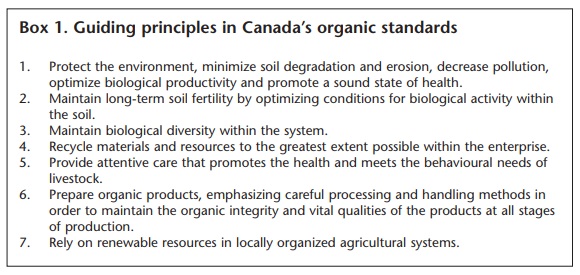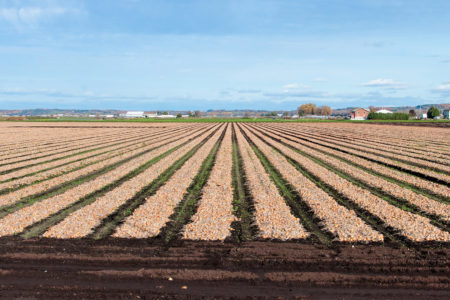
When the United States Department of rule for the National Organic Program in 1997, it included language that would have allowed the use of genetically engineered (GE) organisms, despite the recommendation of its own advisory board. However, after receiving more than 275,000 letters opposing the allowance of GE crops under organic management systems, USDA revised its proposed rule in 2000 to clearly designate genetic modification an “excluded method” in organic production. This brought the final US program (implemented in 2002) into alignment with the rest of the world’s government-regulated and industry private standards.
Since then, the global organic trade has mushroomed into a market worth over $55 billion per year, with 96 percent of this concentrated in Europe and North America. Globally, the increase in organic production is far outpaced by the growth in market demand, leading to a significant bottleneck in traditional and emerging markets.
Canada’s own market doubled its sales from $1 billion in 2006 to $2 billion in 2008, and some estimates have put Agriculture (USDA) first published its proposed sales at $2.6 billion in 2010. The domestic market imports approximately 75 percent of its products, a large share of which come from the US (fresh and grocery) and South America (fresh), but it also comes from Europe and elsewhere. Canada exports up to $390 million per year of organic goods, from raw commodity to finished products. Some of the world’s largest organic companies and most recognizable brands call Canada home: SunOpta, Nature’s Path Foods and Crofter’s Organic, for example.
Over the past 10 years, organic farming in Canada has expanded at an average annual rate of 8 percent (small in comparison with the growth in the demand) and continues to buck trends in agriculture by remaining a profitable and compelling choice for young and new-entrant farmers. Nationally, there were over 3,900 certified organic farms in 2009, with Saskatchewan and Quebec responsible for over half of them. Another 1,200 operations exist as certified handlers and food processors (including seed cleaners), with a concentration in Quebec, Ontario and British Columbia.
Canada’s national organic standards are overseen by the Canadian General Standards Board (CGSB). The Technical Committee on Organic Agriculture at CGSB is made up of approximately 45 voting members and a further 50 information members, and operates on a consensus model. Organic farmers, processors, consumer groups, animal welfare groups, commodity, distributor and retail groups, as well as government agencies and departments, are represented on the committee. The CGSB first published the organic standards as voluntary national standards in 1999.
In 2009 the Canadian Food Inspection Agency (CFIA) implemented the Organic Products Regulations, making Canada’s national organic standards mandatory for domestic and imported products. Originally promulgated in 2006, the regulations built upon the industry’s pre-existing system of organic production and processing standards, inspection, certification and accreditation. Under the new national regulations, the CFIA is the accreditor of the entire organic system in Canada, and thereby oversees and enforces the organic inspection and certification system, organic claims in the marketplace, and the use of the “Biologique Canada Organic” logo, which enables consumers to identify products that meet Canada’s organic requirements. Additionally, the CFIA can enter into recognition or equivalency agreements with foreign governments.
Recent equivalency trade agreements with the US (June 2009) and EU (June 2011) have given Canada exclusive access to the world’s two largest organic markets, enabling the free flow of organic goods between Canada, the US and the EU. So unique is this progressive approach to domestic regulation and international market access that Prime Minister Stephen Harper and President Barack Obama made reference to the landmark US-Canada organic equivalency when establishing the Regulatory Cooperation Council following their February 2011 talks on continental security and trade.
But the quandary at the heart of today’s organic trade in Canada and the US is that due to the rapid growth in prevalence of GE organisms in agriculture, organic products are increasingly at risk of exposure to GE traits. Yet, if contamination occurs (through measures beyond the farmer’s control, such as genetic “drift” or commingling from shipping containers), it often results in the loss of buyers, market access and value; the product was grown true to the organic process, but the endproduct cannot be marketed successfully as organic: it has lost its “organic integrity” and is often sold at a loss as a conventional product, as feed, or it is simply destroyed.
Because of this meeting of process and product in the marketplace, the debate between organic production and biotechnology presents many policy questions: tort law and liability; the outer limits of patent law and intellectual property; and the tensions that become evident when public health, food safety, environment and trade policy intertwine.
Organic production follows practices and principles many in agriculture would identify with, regardless of how they grow (see box 1)
Along with sustainability, the precautionary principle is fundamental to organic standards worldwide, and is the primary reason why Canada’s national organic standards prohibit GE organisms or byproducts, cloned animals or their descendents, elements of nanotechnology, sewage sludge, and persistent toxic synthetic pesticides and fertilizers.
Canadian studies have found organic farming benefits soil quality, reduces nutrient run-off, and can play a role in mitigating climate change. It has also been shown that biodiversity is significantly increased on organic farms, which have a richness and abundance in birds and insect pollinators. This is significant when colony collapse and other challenges are impacting bee populations, traditionally relied upon by all agriculture. Moreover, organic farming tends to use less energy: a 12-year Manitoba study found energy use was 50 percent lower under organic management, while other research has found a 30 percent reduction in energy inputs, increased carbon sequestration, and reduced reliance on fossilfuel derived fertilizers. The connection to consumers and consumer preferences that organic agriculture responds to, as well as its pioneering of identity preservation and product traceability, make it a modern system of production with real solutions to some of the challenges we face today.
Because of these factors, along with obvious consumer demand for it and its increasing profitability for family farms, organic food should be considered by Canadian policy-makers as an important part of the agricultural sector in Canada and a market success story.
Over 90 percent of soybeans, 95 percent of sugar beets, 93 percent of canola and approximately 85 percent of corn is now GE in North America, and a host of other commodities are in production or development, or awaiting approval. Biotech companies have long promised that their innovations would feed the world, grow more crops, and add value for farmers. Many of these promises come with chemical or genetic strings attached, while the promises themselves have been elusive over the past 30 years.
The overwhelming majority of GE crops do not offer improved nutritional characteristics or improved production by virtue of their genetic traits, but rather as a result of their engineered resistance to herbicides (glyphosate or gluphosinate), or of internalized insecticides (the bacterial toxin bacillus thuringiensis, Bt), many of which are marketed in tandem with the GE seed.
Recently, some of these promises seem to be losing their lustre. Take research from the University of Sherbrooke published in the May 2011 issue of the journal Reproductive Toxicology: researchers Aziz Aris and Samuel Leblanc found an incredible 93 percent of maternal blood samples and 69 percent of non-pregnant women tested positive for the Bt toxin. More worrisome, 80 percent of fetal blood samples also tested positive for it. The bioaccumulation of Bt toxins contradicts the longstanding assurance that transfer beyond the digestive tracts of humans or livestock was impossible. Although this bacterium has long existed in nature, and is even used in certain applications as a bio-pesticide on some organic farms, the use of Bt toxin at a genetic level, integrated into the living tissue of GE crops, is concerning in light of this first evidence of transference from plants to humans or animals.
Obviously this research needs to be replicated, and further study into the toxicology of Bt is also a priority. But the Aziz-Leblanc study obliges us to ask: what are the possible health consequences of having this toxin present in the bloodstream of our population? And how exactly were these approvals originally reached without identifying this as a significant risk in the first place?
The emergence of this information suggests the companies seeking approval of Bt events were complacent in their assessment. More damning, perhaps, it also suggests our government regulators were equally complacent, or complicit, in their review. As Jonathan Latham of the Bioscience Resource Project, writing in the Guardian this June, summarized: “It is hard to imagine a finding more damaging to the credibility of GM regulatory institutions.” The fact that GE plants and animals are approved in Canada based on data supplied by the applicants seeking the approvals does not build confidence that similar scenarios will not continue to emerge. The development of GE glyphosate-resistant alfalfa also presents a caution.
The rationale for GE glyphosateresistant alfalfa has been framed as offering a broad range of benefits in response to ill-defined problems: according to the sell-sheet, “the Genuity® Roundup Ready® Alfalfa system provides the opportunity to deliver unsurpassed weed control with superior crop safety, allowing you to grow more, higher-quality alfalfa.” One would assume that alfalfa growers have long suffered the scourge of pests, weeds, and low yields. However, according to the USDA, less than 7 percent of alfalfa in the US is grown with any herbicides, begging the question: what is the problem that Roundup Ready® Alfalfa solves?
While the problem is mysterious and the benefit debatable, the risk for farmers is not, and for organic farmers especially. The risk is significant for them because they rely on very precise crop rotations and nutrient cycling, rather than applications of synthetic soluble fertilizers, in order to provide their soil and plants the nutrients needed for production. Alfalfa is one of the most important of these rotations, particularly for nitrogen-fixing and to prevent soil erosion. It is also essential as a feed in dairy production, which plays an integral role in the Canadian organic value-chain, connecting forage and grain growers with a network of livestock operators and with centralized processors of a range of value-added and high-demand organic products. Alfalfa is also a high-risk for GE contamination because it is a perennial, its pollen can be carried more than eight kilometers by bees, and wild varieties exist across the country and could contribute to genetic drift. What’s more, its seeds are incredibly small (about the size of a poppy seed) and therefore difficult to control or commingling risk. Finally, Canada is one of the major producers and exporters of alfalfa to world markets, many of which would surely close their borders should our supply become compromised.
Along with sustainability, the precautionary principle is fundamental to organic standards worldwide, and is the primary reason why Canada’s national organic standards prohibit GE organisms or byproducts, cloned animals or their descendents, elements of nanotechnology, sewage sludge, and persistent toxic synthetic pesticides and fertilizers.
GE alfalfa is an example of what led Wendell Berry to advocate for “solving for pattern” — whereby “solutions” should work on multiple levels rather than “solving for a single purpose or goal, such as increased production.” In his view, narrow solutions often exacerbate the original problem or create new, more complex problems.
Responding to concerns expressed by many organic and conventional producer groups, in early 2011 the House Standing Committee on Agriculture considered a Liberal member’s proposal for a moratorium on GE alfalfa (though it died with the March election call).
What was unique about the proposed moratorium was that it implicitly recommended a system of monitoring and verification of GE management/segregation controls, as well as calling for public, transparent research into (a) Canada’s ability to ensure the genetic integrity, production and preservation of a diversity of genetically modified organisms (GMOs) and non-GMO and organic alfalfa production; (b) the ability of Canada’s handling and transportation system to ensure segregation of forage seeds and detection of genetic commingling in alfalfa seeds and hay; and (c) the development of industry-led, thirdparty audit and verification systems.
While the committee debated the proposal, Minister of Agriculture Gerry Ritz indicated to the Canadian Cattlemans’ Association that he was aware of concerns and did not intend to proceed: “We look at a number of factors including net benefit and so forth but having said that, there has been no demand for it so we have no intention of moving forward” (quoted in the Western Producer).
Unfortunately, GE alfalfa was in fact approved in Canada in 2008 for “unconfined release into the environment and use as livestock feed” and merely needs to be registered before it can be commercialized. Unless the Minister of Agriculture chooses to intervene, GE alfalfa can move forward on its own timeline.
Agriculture and Agri-Food Canada is currently in the middle of an industry consultation on a “low level presence” (LLP) policy. If adopted, such a policy would allow the presence of a relatively small amount of GE seeds, approved by the exporting country but not the importing country, to enter without consequences or controls — in other words it would allow the import of GE products that have not undergone Canadian environmental or health assessments.
Many commodity groups and representatives of the biotechnology sector view an LLP policy as a pragmatic way of avoiding major trade disruptions due to the time-lag involved in having various countries approve new GE varietals being marketed by multinational biotech companies. Critics of the approach see it as a loss of sovereignty that undermines Canadian regulators’ ability to review or restrict new GE crops from widespread release.
Lorne Hepworth, President of CropLife Canada, is quoted in a release published by the Council for Biotechnology Information as saying: “Detection technology has become so incredibly fine-tuned that one flax seed in a sea of 10,000 is detectable. Trace levels of GM crops approved in one or more countries should not be impeding the movement of much-needed commodities around the world.”
The sort of detection that Hepworth speaks of is what led to one of the most significant trade disruptions in the Canadian flax industry in 2010. The presence of “Triffid” flax was discovered in Europe (at the same ratio of 1 seed to 10,000) and resulted in the disruption of Canadian flax sales to the region, which buys approximately 70 to 80 percent of Canada’s harvest. Organic and conventional flax farmers were impacted equally by Europe’s response to the GE contamination of flax.
Triffid flax was developed in the 1990s at the University of Saskatchewan but was later deregistered and all seed destroyed in order to protect Canada’s access to Europe’s lucrative markets. Somehow, by nature or design, enough Triffid flax survived to compromise the entire $320-million industry. (Somewhat ominously, the “Triffid” GE flax was named after a 1950s science fiction novel featuring venomous, mobile plants of unnatural origins that prey upon and decimate the human population.)
A similar situation in 2006, involving the release of Bayer’s experimental GE rice into the US, led to extensive market closures and strict testing requirements. On July 1, 2011, the contamination was the subject of the largest GE settlement to date, valued at $750 million, to end lawsuits by about 11,000 US farmers, who said a strain of the company’s rice tainted their crops and ruined their export value.
An LLP policy, it is argued, would mitigate this risk and keep mere technical differences from becoming such costly trade barriers. Although the likelihood of Europe and much of Asia adopting such a policy is highly questionable, the argument goes that Canada must establish an LLP policy before calling on others to do so.
Yet, in the same publication by the Council for Biotechnology Information, Dennis Stephens of the Canada Grains Council says “once a new event is approved… it’s not a matter of if it will show up in trace amounts in unintended products, it’s what day it will show up.”
It is unclear whether this admission is supposed to be reassuring; however, it does confirm that few now maintain it is possible to control the spread of GE crops and traits once they are released. The organic sector’s primary concern is that this LLP policy would likely have the opposite effect of its intended purpose by actually increasing the risk to organic and nonGE products and producers in Canada, and therefore would increase market barriers, resulting in financial losses and, in certain instances, the substantial rejection of entire commodities under organic production.
Perhaps most troubling in considering the move to an LLP policy, though, is this “1 seed in 10,000” number, as it shows up in some other research.
In February 2011, Syngenta was granted full deregulation in the US for its Alpha Amylase Maize — the first GE plant commercialized for biofuel production. The corn produces a microbial enzyme that breaks down starches, making biofuel production more economical. During the review phase, the North American Millers’ Association contracted cereal researcher Wayne R. Moore to investigate its possible ramifications for food and feed corn. The study concluded that 1 kernel of the GE ethanol corn in 10,000 could drastically change and “render an entire lot (truck, rail car, silo) of corn unusable,” impacting everything from shelf life and quality, to the viscosity and functionality of a ubiquitous ingredient in today’s food products. However, these concerns were insufficient for the review to reject Syngenta’s ethanol corn. In light of a possible Canadian LLP policy though, these concerns are striking, particularly given the minute amount of GE material it would take to have a profound impact on non-GE product.
In response, Syngenta clearly states that its corn will be grown under a “tightly managed track-and-trace system [which] will maintain quality standards for the dry grind ethanol process while virtually eliminating the potential for misdirection of grain that may result in starch functionality impacts in some industrial and food processes.”
Risk management practices are laudable but, if Stephens is to be believed, it is not so much a question of “if” this corn makes its way into unintended products, but rather “what day it will show up.” On that day, with an LLP policy in place, Canadian millers, manufacturers and consumers may have little recourse.
With these few examples broadly outlined above, it seems there is room to question the health and environmental assessments of novel GE organisms. The regulatory approval process is also susceptible to accusations of the appearance of a conflict of interest. Meanwhile, the paucity of public or third-party data on the potential risks or health impacts to human or animal populations should not be cause for reassurance. Quite the opposite, in fact.
In light of emerging health concerns, Canada should review all approved Bt events and put in place transparent measures for environmental and health assessments, which must include a more rigorous scientific review by third parties. Until such measures are in place, a full moratorium on all new GE approvals or registrations is required.
Further, when considering an LLP policy for Canada, we must be clear that it represents very significant policy departure away from the long-espoused “science-based” approach to the approval of new GE traits or crops (or, increasingly, fish and animals) toward market access considerations. During debate on the NDP’s Bill C-474 last February, which proposed that before we approve new GE crops we first assess whether our current export markets may be disrupted by that decision, the government’s response was that GE traits are approved solely on “sciencebased” criteria and not on market access considerations. However, an LLP policy is in fact the tacit approval of environmental and livestock release of unapproved GE traits through little more than market access measures.
In truth, what we are confronted with here is one problem and two possible solutions. The problem is the loss of market access due to GE’s adventitious presence: it is confronting organic, identity-preserved, conventional and biotechnology marketers.
The solution from the organic perspective is to “solve for pattern” — to reduce risk for all parties through compulsory best management practices to avoid GE contamination of non-GE systems (this could include dedicated nonGE growing regions or placing the onus on GE growers to maintain isolation buffers), to establish a liability scheme and a central fund to finance prevention and mitigation measures and, where necessary, to compensate for damages.
Only after a liability scheme is in place can crops be systematically tested against a defined contamination or low-level threshold. With a robust liability and management system in place for all parties, the threshold can be used for three purposes: to support the positioning of Canadian organic products as a non-GE option for consumers, to identify those products or shipments that have a “low-level presence” and are therefore “low risk,” and to offer a concurrent labelling scheme that meets the clear consumer demand to be able to identify those products that have a GE level above this threshold.
On the flip side, the solution from the biotechnology perspective is to reduce the controls on the GE presence further, to such an extent that all products and sectors are exposed to them, regardless of whether or not this impacts their market designation, export market access, food quality, consumer preferences or other essential conditions of business. This solution merely creates further problems for all but the biotech sector.
There is a contradiction in terms here that requires dedicated policy attention to address. It is a dichotomy likely to keep tort law strong for decades to come, unless the Canadian government determines it is in the interests of all parties in our diverse agricultural sector to find a means of mitigating these risks and establishing sound management practices and traceability systems for all.
Canada, as one of the countries most invested in GE production, and as the home of one of the world’s most respected and progressive organic standards and regulatory systems, finds itself in a policy vacuum that will require a coordinated strategy if the competitiveness, diversity and profitability of our agriculture is to be preserved over the coming years.
Photo: EQRoy / Shutterstock








